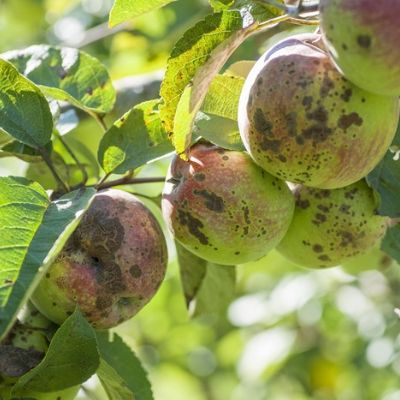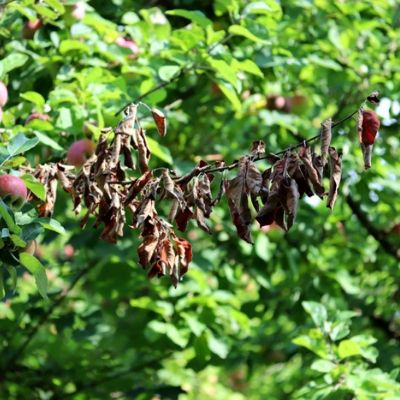Posted on June 25th, 2019
Fruit trees are a great way to spruce up your yard and add a bit of interest. Nothing’s better than walking out into your backyard and picking a fresh peach or apple. Whether you causally grow fruit trees or grow them to sell, you want to protect them from the myriad of diseases that can affect them and affect your yield. Here’s a list of common fruit tree diseases found in Massachusetts.

Apple scab can exhibit such symptoms as dark spots or lesions on leaves and fruit. The spores are spread during rain or carried by the wind to infect nearby trees. Affected trees can start to defoliate by mid to late summer, making them more vulnerable to other pests and diseases. The first line of defense is to plant different varieties that are resistant to the disease. The second line of defense is to clean up infected fruit or leaves. Pathogens can overwinter in tree debris and become active again in the spring.
If you have an apple tree or bought them from a farmer’s market, then you have probably seen sooty blotch or fly speck before. It appears as green or brown spots on apples and looks like a scab on the fruit. The spots are harmless and doesn’t damage the fruit or reduce yield but it can reduce it’s attractiveness and market value.
Powdery mildew can affect a wide range of plants, including trees. When you see it, you might think that the tree’s leaves were dusted with flour. These white spots can spread over the leaf, causing disfigurement.
To control powdery mildew, remove all debris under the tree, prune infected branches, and destroy them. The disease can be spread by the wind so don’t compost or leave them in a pile anywhere on your property. Pruning out healthy branches can increase circulation to help reduce humidity which can spread the disease.

Fire blight is a common and destructive disease in fruit trees such as pear, apple, and crabapple. This is not a superficial disease; it can destroy branches or even the entire plant. The disease presents itself in the spring as a watery liquid that oozes from holes or cankers in the bark. Diseased flowers and leaves will wilt and turn black and usually hang onto the tree throughout the year, making the tree look scorched or burned.
Fire blight overwinters in cankers, branches, or trunks. The disease becomes active in spring and can be transmitted to other limbs or trees by rain or insects. Bees can even carry the disease when they take pollen from infected blossoms.
As the name suggests, peach leaf curl affects peaches and nectarines. It’s one of the most common diseases of these fruits and appears as spring temperatures rise. It presents itself as red areas on leaves that can cause leaves to look disfigured or curled. If enough leaves are infected it can reduce the yield of the tree. The disease overwinters underneath the bark and around buds. In the spring the wet weather helps the spores travel to other areas of the tree.
If you suspect your trees could be diseased, then call the professionals at Turf Unlimited. With our tree care program, we can get your trees back in shape and looking their best. Just call (888) 649-9919 or contact us on our website for more information.
Got a pest problem? Check out our sister site, Pest Control Unlimited.